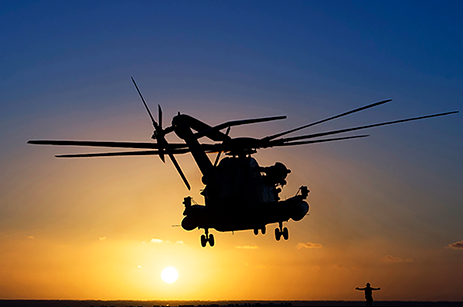
Air data computers are used by aircraft to acquire and process data from pitot and static pressure sensors, data buses, and analog inputs to obtain key air data parameters such as altitude, airspeed, height deviation, and temperature to ensure safe and accurate flight, on both rotary and fixed-wing aircraft. This video explains the fundamental operation of air data computers and how they derive information from pressure readings.
Video Transcript
Air Data Computers use pressure measurement to calculate the velocity and altitude of an aircraft. More familiar forms of pressure measurement are; determining the pressure in a tire, taking someone’s blood pressure, and the atmospheric pressure shown on weather charts.
The forward speed of an aircraft is determined by measuring the pressure building up in front of it. It is known as Pitot Pressure. As an example of forward pressure, the picture on the left shows that as this car was traveling forward, the highest amount of pressure which is depicted in red was exerted on the flattest, most forward-facing part of the body. This pressure build-up can be reduced by streamlining. On an aircraft, the forward pressure is channeled into the tube, known as a Pitot Tube, which is connected to a pressure sensor inside the Air Data Computer.
The altitude of the aircraft is computed using atmospheric pressure. This picture shows the difference in air pressure at sea level, compared with that at the peak of Mount Everest. As the height increases, the density of air molecules reduces. This is why climbers must take oxygen tanks with them at high altitudes. This reduction in the density of air molecules also causes a reduction in air pressure. So, as altitude increases, air pressure decreases. On an aircraft, this reduction in air pressure is measured through the static port which is also connected to a pressure sensor inside the air data computer.
As the aircraft sits on the ground, the static or vertical pressure is at its highest, as the atmosphere is denser at ground level. Also, on the ground, the aircraft is not generating any forward pressure, so the Pitot Pressure is low. As the aircraft gains altitude, the static pressure reduces and as the aircraft moves forward the Pitot pressure increases.
Air data computers are attached to the ports of the aircraft as depicted in this picture. The Pitot probe faces forward collecting pressure which the Air Data Computer converts to knots and the static port is located on the side of an aircraft in a position where it is least affected by forward pressure.
Pressure is not the only thing needed to compute altitude and airspeed. Other conditions that Air Data Computers take into consideration include
- Angle of Attack – Angle between a reference line on the body and the oncoming airflow
- Vertical Speed Indicator – How fast the aircraft is climbing or descending to name a couple
These are only a few examples of the types of information the computers handle. Some are standard across all product types, others vary from unit to unit.